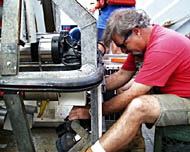|
|
  TODAY'S WEATHER Partly cloudy 82.4°F (28°C) Latitude: 3 deg 23’N Longitude: 102 deg 12’W Wind Direction: calm Sea State: 1 Swell(s) Height: 4-6 Foot Sea Temperature: 86°F (30°C) Barometric Pressure: 1013 MB Visibility: 10-25 Nautical Miles  Breakfast Cow patties (frittatas) Hash browns and waffles Bacon and sausage Eggs to order Hot cereal Banana nut bread Lunch Tuna salad sandwich Pasta with sun-dried tomatoes Curly fries Chicken noodle soup Salad bar Dinner Seafood Creole Blackbean chili with rice Hush puppies Salad bar Bread pudding  There is no light whatsoever
on the deep ocean floor. To take photographs of the ocean bottom,
it is necessary to illuminate the seabed with powerful lights mounted
on Argo. P.J. Bernard, a WHOI engineer, is shown here adjusting the lights at the
back end of the Argo vehicle.
There is no light whatsoever
on the deep ocean floor. To take photographs of the ocean bottom,
it is necessary to illuminate the seabed with powerful lights mounted
on Argo. P.J. Bernard, a WHOI engineer, is shown here adjusting the lights at the
back end of the Argo vehicle.
Fish, Fish and MORE Fish! This morning, we were busy towing the DSL-120 sonar along the last line of our initial survey over the East Pacific Rise near 3° 20’N (check out the slide show to see a three-dimensional bathymetric model of the seafloor that Uta Peckman has been working on). The axis of the mid-ocean ridge in this area actually splits into two ridge crests that overlap by about 26 kilometers. Our analysis of the sonar data over the past two days suggests that an area near the tip of the southern ridge, near the western margin of the basin between the two ridge crests, may be where the new lava erupted about four years ago. This area is right along the line where the earthquake events recorded in the AHA data are located. At about 2000 hours, we brought the sonar fish back on deck, and the Deep Submergence Operations Group team started detaching the fiber optic cable from the DSL sonar system so that is can attached it to the Argo II photographic and imaging system which we plan to use tomorrow to collect images of the seafloor. While this is being done, we are going to send a rock dredge down tonight to collect some lava samples. The rocks should help us to see whether the lava has been recently erupted. If the lava is very glassy that would be a good indicator that it is young. Early this morning, the water surrounding the ship was a layer cake of fish. Seriously! About 10 meters down, there was a big school of tuna of different species. Just below the surface, there was a large school of Mahi Mahi (dolphin fish). The “icing” on the fish layer cake was a large school of flying fish and squid, jumping and trying to escape being breakfast. I have never seen such a sight! Many members of the crew and even the science party had a chance to fish, and just about everyone caught a fish. The “Dave’s” (Murline and Grimes) caught dozens between them and have us well-stocked with fresh fish for the next few days. Dave is an expert fisherman and knows a lot about all the fish in this area. He wrote some basic information about all the different types of fish that were caught this morning so that you could learn more about them. *Dave Murline's Fish Facts* Dolphin Fish (Coryphaena hippurus)-- also known as Dorado or Mahi Mahi. They grow to 90 pounds and over 6 feet in length. They are “pelagic” fish, which means they live in the open ocean rather than in coastal areas. They live worldwide in temperate to tropical waters warmer than 65°F. They feed on flying fish, squid and crustaceans. They are known for their acrobatic fighting -- jumping several times in order to “spit” the hook when they are caught. They are a beautiful turquoise blue and yellow when swimming in the ocean, but they turn green and gold when hooked, and then they fade to blue gray as they die. The ones we caught were probably around 1 year old and weighed 5-15 pounds. They are excellent to eat when fresh, but spoil rapidly. Skipjack
Tuna (Euthynnus pelamis)-- also known as Skippies or Aku.
They grow to 30 pounds and 3 feet in length, and live for about 7 years.
They are pelagic fish, and live worldwide in temperate to tropical
waters warmer than 68°F. They feed on bait fish, sardines, anchovies,
squid, and crustaceans. They are named for the way they feed on the
water by skipping over the surface. Skipjack are good barbecued when
fresh, and they make great sashimi (thin slices of raw fish) and fish
jerky (thinly sliced, salted and dried fish). They are also commonly
used in low-grade canned tuna or as cat food. Skippies are usually
caught incidentally when hunting for other species of tuna, but they
are fun to catch. The Skipjack Tuna we caught were probably about a
year old.
|
|||||||||||||||||||||||||||||||||||||||||||||||||||||||||||||||||||||||||||||||||||||||||||||||||||||||||||||||||||||||||||||||||||||||||||||||||||||||||||||||||||
© 2010 Dive and Discover™. Dive and Discover™ is a registered trademark of
Woods
Hole Oceanographic Institution
